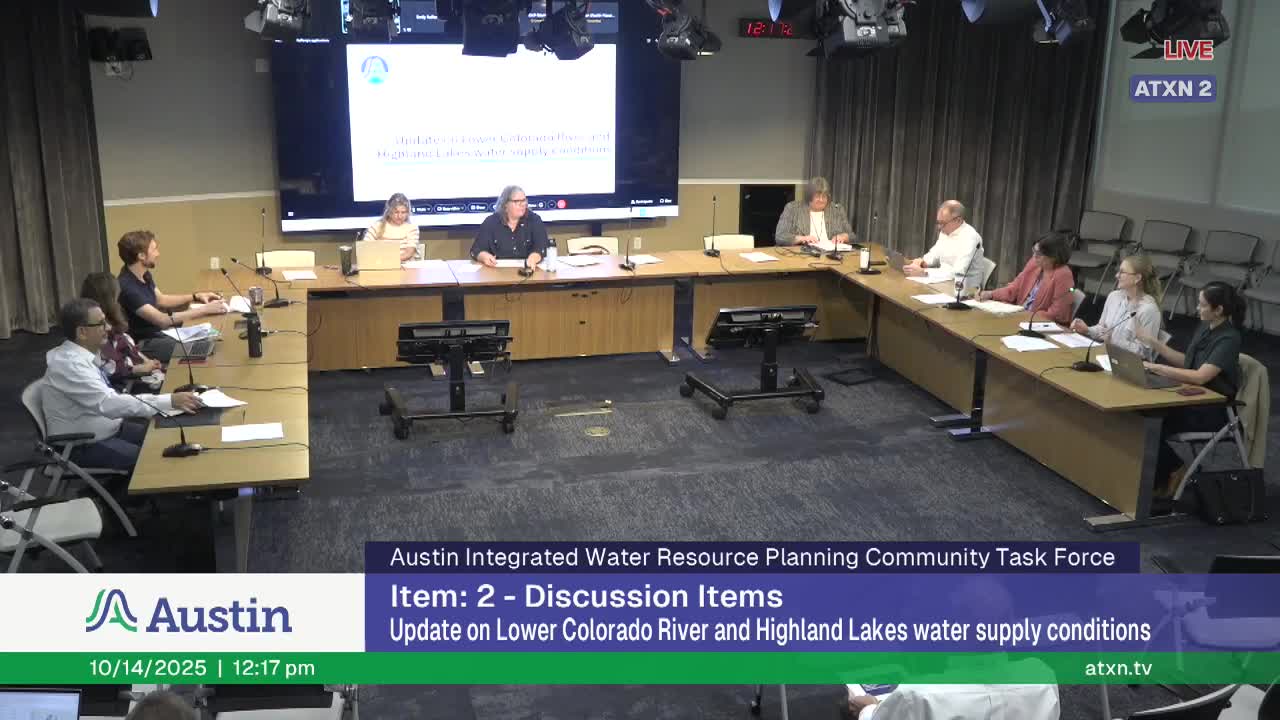Highland Lakes storage has fallen since July inflows; Austin officials warn drought risk remains
October 14, 2025 | Austin, Travis County, Texas
This article was created by AI summarizing key points discussed. AI makes mistakes, so for full details and context, please refer to the video of the full meeting. Please report any errors so we can fix them. Report an error »

Austin Water staff told the Implementation Task Force that although July 2025 brought substantial inflows to the Highland Lakes system, combined storage has declined since and basin forecasts continue to favor dry conditions.
Emily Rafferty of Austin Water presented Highland Lakes inflow and storage charts showing a July spike (about 760,000 acre‑feet of inflows) and a current combined Lakes Buchanan and Travis storage of about 1,760,000 acre‑feet. Rafferty said current storage is roughly 88% full and that, if storage follows an extreme‑dry projection, combined storage could fall to about 1,650,000 acre‑feet by April 2026.
Rafferty walked the task force through the US Drought Monitor map for Texas and the NOAA three‑month outlook; NOAA is forecasting above‑average temperatures and below‑average precipitation for November–January. The presenters noted the El Niño Southern Oscillation (ENSO) outlook favors a weak La Niña into the Northern Hemisphere winter, which typically brings warmer, drier conditions to Texas.
Task force members asked about large customers and whether new facilities (including data centers) could meaningfully increase demand. Austin Water staff said they were not aware of a specific large customer imminently coming online that would dramatically change the LCRA projection, and that LCRA includes known large loads in its modeling. The utility also noted its benchmarking and site‑development review process requires certain large developments to trigger extra review; staff said developments larger than 250,000 square feet have benchmarking and consultation requirements.
Ending: Staff and task force members agreed on continued monitoring and public messaging focused on sustained conservation, noting that reservoir gains from July offer runway but not relief from drought conditions.
Emily Rafferty of Austin Water presented Highland Lakes inflow and storage charts showing a July spike (about 760,000 acre‑feet of inflows) and a current combined Lakes Buchanan and Travis storage of about 1,760,000 acre‑feet. Rafferty said current storage is roughly 88% full and that, if storage follows an extreme‑dry projection, combined storage could fall to about 1,650,000 acre‑feet by April 2026.
Rafferty walked the task force through the US Drought Monitor map for Texas and the NOAA three‑month outlook; NOAA is forecasting above‑average temperatures and below‑average precipitation for November–January. The presenters noted the El Niño Southern Oscillation (ENSO) outlook favors a weak La Niña into the Northern Hemisphere winter, which typically brings warmer, drier conditions to Texas.
Task force members asked about large customers and whether new facilities (including data centers) could meaningfully increase demand. Austin Water staff said they were not aware of a specific large customer imminently coming online that would dramatically change the LCRA projection, and that LCRA includes known large loads in its modeling. The utility also noted its benchmarking and site‑development review process requires certain large developments to trigger extra review; staff said developments larger than 250,000 square feet have benchmarking and consultation requirements.
Ending: Staff and task force members agreed on continued monitoring and public messaging focused on sustained conservation, noting that reservoir gains from July offer runway but not relief from drought conditions.
View the Full Meeting & All Its Details
This article offers just a summary. Unlock complete video, transcripts, and insights as a Founder Member.
✓
Watch full, unedited meeting videos
✓
Search every word spoken in unlimited transcripts
✓
AI summaries & real-time alerts (all government levels)
✓
Permanent access to expanding government content
30-day money-back guarantee

